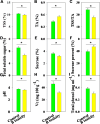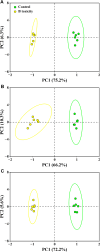Excessive boron fertilization-induced toxicity is related to boron transport in field-grown pomelo trees
- PMID: 39319002
- PMCID: PMC11420558
- DOI: 10.3389/fpls.2024.1438664
Excessive boron fertilization-induced toxicity is related to boron transport in field-grown pomelo trees
Abstract
Boron (B) is an essential micronutrient for plant growth and development; however, the process of B toxicity in citrus production is still poorly understood. We proposed a hypothesis that B toxicity in citrus trees is related to the characteristics of B transport from soil to leaf or fruit. For this, a field experiment was conducted for two treatments, control (B free or without B) and B fertilizer treatment (100 g Na2B4O7·10H2O plant-1), to investigate the effects on plant growth, nutrient uptake, fruit yield and quality, and B transport in 10-year-old pomelo trees [Citrus grandis (L.) Osbeck cv. Guanximiyou]. Our results showed that excess B fertilization directly led to B toxicity in pomelo trees by dramatically increasing soil total B and water-soluble B contents. B toxicity induced interveinal chlorosis in leaves and decreased leaf biomass and function, resulting in a decreased 45.3% fruit yield by reducing 30.6% fruit load and 21.4% single fruit weight. Also, B toxicity induced changes in mineral elements between leaf positions and fruit parts, in which the concentrations of B, potassium, and magnesium were increased while those of nitrogen and iron were decreased. Under B toxicity conditions, fruit quality parameters of total soluble solids (TSS), TSS/titratable acidity (TA), total soluble sugar, sucrose, pH, vitamin C, and total phenol contents decreased, which were regulated by the lower carbohydrate production in new leaves and the lower transport capacity in old leaves. Moreover, B toxicity significantly increased the transfer factor and bio-concentration factor of B in pomelo plants, with higher levels in leaf organs than in fruit organs. Taken together, excess B fertilization-induced B toxicity in pomelo trees, with induced growth inhibition and nutrient disorder, results in reduced fruit yield and quality, which are related to B transport from soil to organs. The findings of this study highlight the understanding of B toxicity in citrus plants and strengthen B management in pomelo production for high yield and high quality.
Keywords: B biochemical cycle; B toxicity; citrus plants; fruit yield and quality; mineral profiles.
Copyright © 2024 Luo, Zhang, Hu, Wang, Tao, Jia, Miao, Chen and Guo.
Conflict of interest statement
The authors declare that the research was conducted in the absence of any commercial or financial relationships that could be construed as a potential conflict of interest.
Figures











Similar articles
-
Reduced Fertilization and Magnesium Supplementation: Modulating Fruit Quality in Honey Pomelo (Citrus maxima (Burm.) Merr.).Plants (Basel). 2024 Oct 1;13(19):2757. doi: 10.3390/plants13192757. Plants (Basel). 2024. PMID: 39409627 Free PMC article.
-
[Citrus boron nutrient level and its impact factors in the Three Gorges Reservoir region of Chongqing, China].Ying Yong Sheng Tai Xue Bao. 2014 Apr;25(4):991-6. Ying Yong Sheng Tai Xue Bao. 2014. PMID: 25011290 Chinese.
-
[Optimized nutrients management improved citrus yield and fruit quality in China: A meta-analysis].Ying Yong Sheng Tai Xue Bao. 2024 May;35(5):1301-1311. doi: 10.13287/j.1001-9332.202405.011. Ying Yong Sheng Tai Xue Bao. 2024. PMID: 38886429 Review. Chinese.
-
Determination of nutritional sufficiency ranges for pomelo (Citrus grandis Osbeck) grown on alluvial soils using DRIS.PLoS One. 2024 Oct 16;19(10):e0312231. doi: 10.1371/journal.pone.0312231. eCollection 2024. PLoS One. 2024. PMID: 39413091 Free PMC article.
-
Valorization of pomelo (Citrus grandis Osbeck) peel: A review of current utilization, phytochemistry, bioactivities, and mechanisms of action.Compr Rev Food Sci Food Saf. 2020 Jul;19(4):1969-2012. doi: 10.1111/1541-4337.12561. Epub 2020 May 31. Compr Rev Food Sci Food Saf. 2020. PMID: 33337092 Review.
References
-
- Boaretto R. M., Quaggio J. A., Mattos-Jr D., Muraoka T., Boaretto A. E. (2011). Boron uptake and distribution in field grown citrus trees. J. Plant Nutr. 34, 839–849. doi: 10.1080/01904167.2011.544353 - DOI
-
- Boaretto R. M., Quaggio J. A., Mourão Filho F. A. A., Giné M. F., Boaretto A. E. (2008). Absorption and mobility of boron in young citrus plants. Commun. Soil Sci. Plan. 34, 839–849. doi: 10.1080/00103620802358383 - DOI
-
- Chen H., Jia Y., Xu H., Wang Y., Zhou Y., Huang Z., et al. . (2020). Ammonium nutrition inhibits plant growth and nitrogen uptake in citrus seedlings. Sci. Hortic. 272, 109526. doi: 10.1016/j.scienta.2020.109526 - DOI
-
- Chen H.-H., Zheng Z.-C., Chen W.-S., Rao R.-Y., Chen X.-F., Ye X., et al. . (2023). Regulation on copper-tolerance in Citrus sinensis seedlings by boron addition: Insights from root exudates, related metabolism, and gene expression. J. Hazard Mater. 459, 132277. doi: 10.1016/j.jhazmat.2023.132277 - DOI - PubMed
LinkOut - more resources
Full Text Sources

